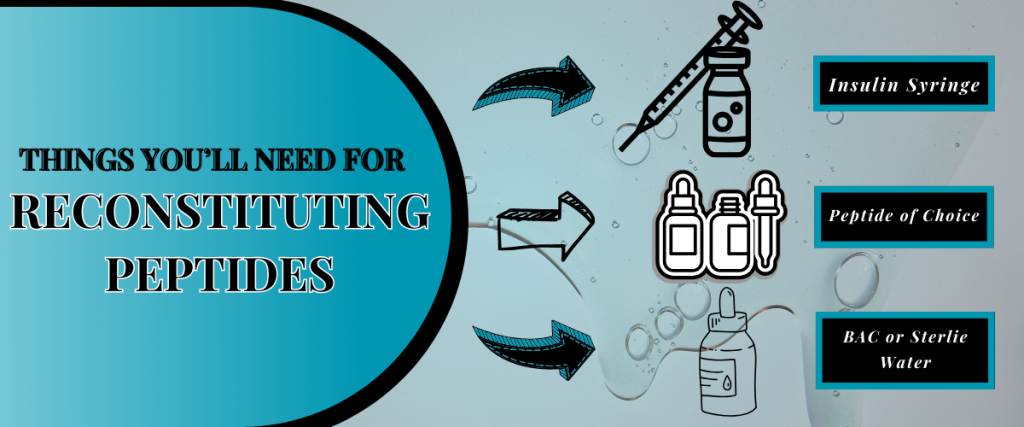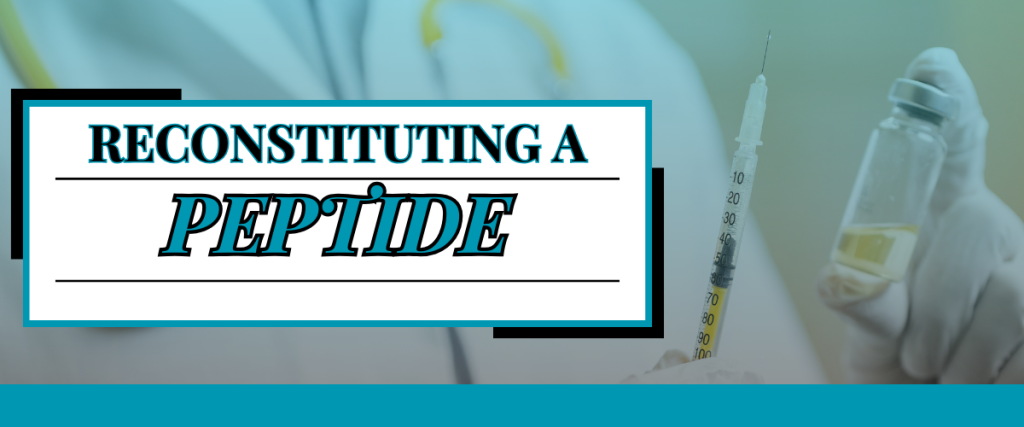Disclaimer: All articles and information available on this website are for educational purposes only.
Ever tried reconstituting a peptide, but can’t figure out all the math and measurements that come with it? I exactly had the same conundrum, and it seems like we’re not alone.
Sure, you could use a peptide calculator, but even that doesn’t help sometimes – there’s just too much to learn and too many factors to consider. So, today I’ll try to explain all this complicated stuff to you as clearly as possible.
I’ll answer some general questions most people have, as well.
I’ll be honest with you, it’s really hard at the start to wrap your head around it, especially if you’re not familiar with the metric system. But once you learn the basics, it’s really easy – you can even convert stuff on autopilot.
Let’s get started.
Reconstituting a Peptide
Okay, before we get to the math stuff, we have to know what reconstituting is first.
I’m sure you’ve heard the term “mixing peptides” from researchers or the bodybuilding community, but it’s more proper term is reconstitution. Let’s break that term down:
- Peptide – is a string of amino acids that when combined with another amino acid, signals your cells on what to do.
Very simply put: peptides give your body instructions to do something. Peptides are freeze-dried through a process called “lyophilization” (which we’ll get to later) so they can be stored for longer.
If you’re interested to know more, here’s an in-depth guide to what peptides are.
- Reconstitution – comes from the root word constitute, a Latin word that means to “form something new.” So, re + constitute means to form something new again.
In scientific terms, reconstitution means to form something again by adding water to it.
In simpler terms, lyophilization means freezing the peptide and then drying it under a vacuum under low temperatures, turning it into a powder.
Due to this, freeze-dried samples last longer than their non-lyophilized counterparts as they inhibit any chemical, biochemical, and microbiological processes from effecting the peptide.
So combining these two together, peptide reconstitution means adding (specific) water to a freeze-dried peptide.
Okay, cool. Now we know that peptides are turned into powder for preservation purposes. However, we’re not done yet – after shipping, we still have to turn it into liquid again (hence, reconstituting it.)
Peptide Reconstituting Framework

This is the part of the article where we have to divide and multiply water and peptide quantities, so I’ll also try to explain it as simply as possible.
You might be asking, why should I do this when I can use a peptide calculator to do it all for me?
Peptide calculators are really confusing when you don’t know all the symbols that come with them, so it’s practical if you know them to ensure you’re reconstituting the right amount for your research.
Why is this important? Best case scenario, you inject the wrong amount of a peptide and your subject doesn’t feel anything different – worst case scenario, the research subject experiences an adverse side effect.
Measurements Guide
Let’s say you got your peptide from a research compound supplier or a compounding pharmacy, you’ll notice that it’s measured in the metric system.
All peptides or compounds come in mg and this is probably what confuses people the most as in the US, we don’t use mL, mg, or mcg– we use the good ole’ imperial system.
Here’s a short measurement table to jog your memory:
| Metric System | Imperial System |
| 1 mcg (microgram) | 0.00000003527396 oz (ounce) |
| 1 mg (milligram) | 0.000035274 oz |
| 1mL (milliliter) | 0.033814 US fl. oz (fluid ounce) |
mL – 1/1000 L. This is a volume measurement used in liquids.
cc – or cubic centimeter, is also a volume measurement that most syringes use to measure their capacity. 1 cc is equivalent to 1 mL, or in other words:
1 cc = 1 mL
mg – 1000 mg is equal to 1 g. This is a weight measurement most peptides use. For injections, we’ll use a weight-to-volume ratio, such as mg/ml (or milligrams per milliliter.)
mcg – 1000 mcg is equal to 1 mg. Typical peptides with mcg in their dose might be ones like BPC-157, Ipamorelin, Hexarelin, AOD9604, and IGF1-LR3 to name a few examples.
Using Bacteriostatic Water Vs. Sterile Water
Peptide vials, once mixed, can grow microbes and bacteria in the vial. We don’t want this! ha
Once you have a pathogen-infested peptide and use normal water (tape water) to reconstitute with, you might cause post-injection inflammation (or post-injection pain on your test subject and set the grounds for infection since it’s not sterile.
Here’s an example picture:

Yikes. Thankfully, you can use two types of water to prevent that from happening: sterile and bacteriostatic (BAC) water.
Sterile Water
Sterile water is purified water that has been distilled. This type of water contains no bacteriostat, antimicrobial, or included buffer agents added to it.
Bacteriostat, also called “Bstatic”, is a substance that prevents bacteria from reproducing.
Since this type of water lacks any type of antibacterial or antimicrobial agent, it can easily become contaminated once exposed to the surroundings, including yourself.
Let’s answer a FAQ:
https://www.facebook.com/groups/sarms.peptides.nootropics/permalink/1171867713668624
For peptide reconstitution, sterile water can work perfectly fine for single use. At best, you can use sterile water for 1-2 days only. You can buy sterile water wholesale or retail at nearby pharmaceutical stores/Amazon.
Bacteriostatic Water (BAC)
BAC water is sterile water combined with a bacteriostatic agent – a compound that prevents bacterial growth. The added bacteriostat is 0.9% mg/mL of benzyl alcohol (benzoic acid).
Let’s answer some FAQs people would have surrounding BAC water:
https://www.facebook.com/groups/sarms.peptides.nootropics/permalink/1358598791662181
BAC water is necessary because it doesn’t kill bacteria but prevents them from growing in the first place. This type of water is usually intended for intravenous, intramuscular, and subcutaneous injections only. BAC water is also used for multiple-use peptides when one is pulling from the same vial for several days or weeks in a row.
https://www.facebook.com/groups/sarms.peptides.nootropics/permalink/1181378869384175
You can buy BAC water from a wholesale supplier such as this one, but most research compound companies sell them alongside their peptides or given BAC water away when a purchase is made.
Finally, if you ask me, get the BAC water – it’s a better version of sterile water and makes your peptides safer to use for longer.
Syringe
After we have the right measurements and water down, we’ll need an appropriate insulin syringe. For this section, we’ll use petidecalc.com to visualize the syringe.
Insulin syringes are perfect for intramuscular or subcutaneous injections and come in multiple sizes – 0.3 mL, 0.5 mL, and 1 mL – to help deliver different doses.
Researchers commonly use a 1mL insulin syringe because it makes math easier with its “units” measurement pictured below.
Note: Each mark in this syringe represents 2 units (or .02 mL)
However, the units are significantly smaller on the syringe in real life. For visual clarity, researchers add around 1-5 mL BAC/sterile water to the vial according to their preference.
For example, let’s say some researcher has a 10mg vial of Melanotan 2 and wants to reconstitute it into a 100 mcg injection on a 1 mL syringe.
If the researcher only adds 1mL BAC/sterile water, they need to pull the syringe to half a unit.
And if they add 3 mL, they need to pull the syringe to 1½ units.
See the problem? To keep things simple, the researcher would probably add 2 mL to the syringe – exactly occupying 1 unit.
Perfect.
Example Peptide Reconstitution
We got the basics down – let’s put what we learned to the test. We’ll use petidecalc.com again to visualize our solution.
Suppose you are a researcher who has a 5mg vial of Semaglutide and wants to reconstitute around 0.2 mg (or 200 mcg) on a 1 mL insulin syringe, how much BAC/Sterile water do you need to successfully reconstitute it?
Boy, this is sounding more and more like a math problem.
- First, you should convert the 5mg into 5000 mcg. We can do that by multiplying the mg by 1000: (5 mg) * (1000 mcg) = 5000 mcg
We’ll only need 200 mcg for our dose, so we’ll store the remaining 4800 mcg for later use.
- After that, we’ll reconstitute the peptide into an injection using BAC or sterile water, which can be anywhere from 1-5 mL depending on your preference. We’ll use 3 mL for this example.
- Lastly, we’ll put the BAC/sterile water in the vial and pull the compound using a 1 mL syringe. This injection will measure as 4 units on the syringe.
Voila, you have just successfully reconstituted a peptide. If we use the peptide calculator, it would look like this:
Peptide Storage Tips
For this section of the article, we’ll go with The National Institute for Biological Standards and Control’s peptide storage guide.
| Note: Do not attempt to shake your peptide before, during, or after reconstituting it. Peptides are really finicky and should be handled with care – it’s not a pill bottle. |
You’ll typically receive peptides in their lyophilized (powdered) form, and I highly recommend storing your peptides in this state until you need to reconstitute them.
Why? Peptides are very vulnerable to degradation, and heat, light, and moisture can accelerate that process. Once you reconstitute peptides, they are generally less stable and should be stored in the right conditions so as not to lose their potency.
Here’s how you could do that:
Storing Lyophilized (Freeze-Dried) Peptides
For short-term storage, lyophilized peptides remain stable for days to up to even weeks at less than 4°C or 39.2°F.
For long-term storage, lyophilized peptides should be kept in a freezer at less than -20°C or –4°F. Any lyophilized peptides stored under these conditions can last for up to 4 years, and there are usually no issues using it for research.
When planning to reconstitute your frozen lyophilized peptide, allow it to thaw out to room temperature before you open the vial, and only do it once.
Storing Reconstituted Peptides
Once reconstituted, peptides should generally be kept around 2-8°C (or 35.6°F to 46.4°F) in a refrigerator at all times.
Should you get this condition right, your peptide will remain potent for around 2-8 weeks before it starts to lose its efficacy, but this can vary depending on the specific peptide.
Storing Unopened Peptides at Room Temperature
https://www.facebook.com/groups/sarms.peptides.nootropics/permalink/1355601978628529
Good question – yes, you can. The peptide won’t lose its potency for up to a few days. However, I recommend storing it at 4°C or 39.2°F and only taking it out when reconstituting it.
The Takeaway
Reconstituting peptides can be hard to wrap your head around at first, but if you break it down, it becomes really, really easy – I bet you’ll find yourself saying, “How did I not get this?”
So, get your volume and weight measurements right, use either BAC or sterile water, and use a syringe of your choice to get the dosage you need for your research.
Not only do you now know what to do and what not to do, but you also receive some peptide storage tips as a bonus for being awesome and getting through to the end of this article.
If you liked this guide, feel free to check out our other articles!







